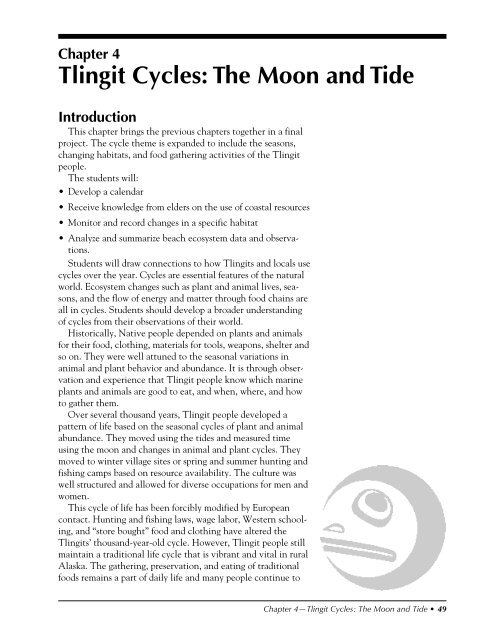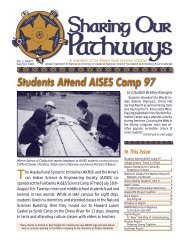Tlingit Moon & Tide - Alaska Native Knowledge Network - University ...
Tlingit Moon & Tide - Alaska Native Knowledge Network - University ...
Tlingit Moon & Tide - Alaska Native Knowledge Network - University ...
You also want an ePaper? Increase the reach of your titles
YUMPU automatically turns print PDFs into web optimized ePapers that Google loves.
Chapter 4<br />
<strong>Tlingit</strong> Cycles: The <strong>Moon</strong> and <strong>Tide</strong><br />
Introduction<br />
This chapter brings the previous chapters together in a final<br />
project. The cycle theme is expanded to include the seasons,<br />
changing habitats, and food gathering activities of the <strong>Tlingit</strong><br />
people.<br />
The students will:<br />
• Develop a calendar<br />
• Receive knowledge from elders on the use of coastal resources<br />
• Monitor and record changes in a specific habitat<br />
• Analyze and summarize beach ecosystem data and observations.<br />
Students will draw connections to how <strong>Tlingit</strong>s and locals use<br />
cycles over the year. Cycles are essential features of the natural<br />
world. Ecosystem changes such as plant and animal lives, seasons,<br />
and the flow of energy and matter through food chains are<br />
all in cycles. Students should develop a broader understanding<br />
of cycles from their observations of their world.<br />
Historically, <strong>Native</strong> people depended on plants and animals<br />
for their food, clothing, materials for tools, weapons, shelter and<br />
so on. They were well attuned to the seasonal variations in<br />
animal and plant behavior and abundance. It is through observation<br />
and experience that <strong>Tlingit</strong> people know which marine<br />
plants and animals are good to eat, and when, where, and how<br />
to gather them.<br />
Over several thousand years, <strong>Tlingit</strong> people developed a<br />
pattern of life based on the seasonal cycles of plant and animal<br />
abundance. They moved using the tides and measured time<br />
using the moon and changes in animal and plant cycles. They<br />
moved to winter village sites or spring and summer hunting and<br />
fishing camps based on resource availability. The culture was<br />
well structured and allowed for diverse occupations for men and<br />
women.<br />
This cycle of life has been forcibly modified by European<br />
contact. Hunting and fishing laws, wage labor, Western schooling,<br />
and “store bought” food and clothing have altered the<br />
<strong>Tlingit</strong>s’ thousand-year-old cycle. However, <strong>Tlingit</strong> people still<br />
maintain a traditional life cycle that is vibrant and vital in rural<br />
<strong>Alaska</strong>. The gathering, preservation, and eating of traditional<br />
foods remains a part of daily life and many people continue to<br />
Chapter 4—<strong>Tlingit</strong> Cycles: The <strong>Moon</strong> and <strong>Tide</strong> • 49



